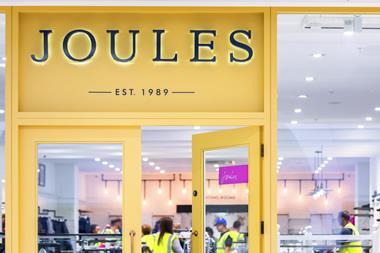After posting an impressive set of full-year results, departing Joules boss Colin Porter pointed to the success of the fashion brand’s ‘total retail’ model. What is that and what can others learn from it?
Where many fashion retailers have suffered under the weight of spiralling costs, inflated business rates, increased online penetration and a seemingly sector-wide focus on discounting in an overcrowded apparel market, Joules is a conspicuous success story.
Joules posted a 19.4% rise in underlying pre-tax profit to £15.5m in the 52 weeks to May 26, and a 17.2% boost in group revenue to £218m. That was off the back of an equally impressive set of results in the previous financial year.
In short, Joules is, in the words of one retail observer, “absolutely flying”.
Departing chief executive Colin Porter puts Joules’ success down to a number of factors including “standout” results in its international markets, particularly the US and Germany, and “a great year developing partnerships with wholesale groups into concession businesses” with retailers such as John Lewis and Next. Additionally, there was constant “focus on the customer and their experience”.
The variety of approaches epitomises the overarching reason for Joules’ continued success – what the retailer calls its “total retail model”.
What is total retail?
According to Joules, the model hinges on uniformly marketing its brand across all its channels and it is “delivered through both owned and third-party platforms”.
GlobalData associate analyst Emily Salter explains: “The total retail model is the theme of linking all the different routes to market that Joules has – ecommerce, stores, concessions, events and online marketplaces – and making sure they are all consistently marketed, and the experience is consistent for customers across them.”

It sounds simple but, according to Porter, it has been 30 years in the making. “It’s in our DNA,” he says, and goes all the way back to the brand’s roots and founder Tom Joule, who still has a role with the business as chief brand officer. His presence in the business means the retailer continues to have a strong focus on product and a design ethos underpinned by its founder.
Porter adds: “It goes back 30 years, to Tom standing in the fields in a tent. The journey evolved from there into a catalogue business, which naturally became an online business. We were online very early on.
“The stores came last, so we’ve been able to build up a store portfolio in more of the current climate, as opposed to say 25 years ago when things were very different.”
The upshot, Porter says, is Joules can be “generally agnostic about where customers shop”, so long as they’re buying the brand’s product from somewhere.
According to Salter, the ability to be “agnostic” about where consumers shop is becoming increasingly important for fashion brands “as consumers change their spending behaviour, moving more online. Retailers need to be flexible in adapting to this.
“Even if the total retail model was around 20 or 30 years ago, it’s become even more important now in creating that seamless experience where stores can support online sales and the other way around.”
Producing results
Whether through luck as much as design, the model has insulated Joules from many of the issues battering competitors in the fashion market, as its results show.
Joules achieved growth across the board. The retailer’s international sales increased by 43.5% and represent 16.1% of group revenues.
Ecommerce advanced 58% and approximately half of group sales come from Joules’ digital channels.
Evidence of the total retail model in action, Porter says, is that a fifth of all Joules’ store transactions last year “were directly in support of a digital sale – be that through click and collect, order in store, ease of return or data capture”.

For joint house broker Liberum analyst Wayne Brown, such statistics show Joules is “fit for the future”.
“Joules is adapting its model to the digital age,” he says. “Not just through the channels it retails through but flexing its supply chain so it can provide greater frequency of newness. This is all being done while accepting that consumers are being more demanding, and costs are rising.”
Brown believes Joules’ strategy has positioned it to continue to make “a profitable transition into the online world” and it is likely to adapt further before Porter steps down in its 2019/20 financial year.
“This may not end up being the exact path that Joules follows as it has already shown itself since its IPO [in 2016] to be an agile and flexible business, which has allowed for relationships with key partners to change,” he adds.
Salter agrees and says Joules’ move into new product lines such as sofas and homewares with partners like DFS, and its international franchise partnerships in the US and the Middle East, “will continue to help drive growth”.
Wider lessons
What then can other retailers with less integrated systems and supply chains learn from Joules’ success with total retail?
For Salter, while it may have different names at other retailers, the success of the total retail model comes down to the way Joules has integrated digital services in-store to support online sales.
She cites a number of other retailers delivering success with similar approaches such as Next and Zara. She believes, at least conceptually, the model can be replicated.
“The model boils down to the idea of having your brand, products and messaging consistently portrayed across all of your channels. It’s a concept which, in theory, shouldn’t be too hard to implement for others.”
Brown, however, is more sceptical and says Joules’ model involves “embracing the opportunity provided by enhanced profit growth, margin expansion and rising cash flow”, which is “a rare mix in the current UK retail landscape”.
But amid tough trading conditions, which show few signs of easing, it is perhaps a mix others must find their own version of if they are to survive as long as Joules already has.


























No comments yet